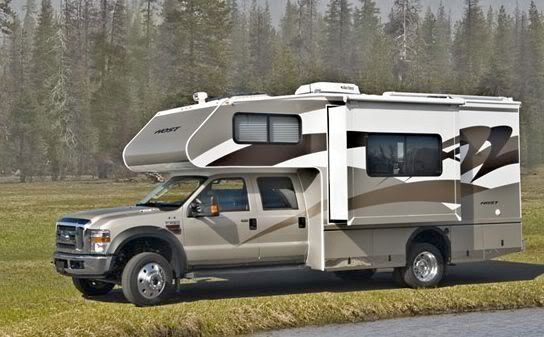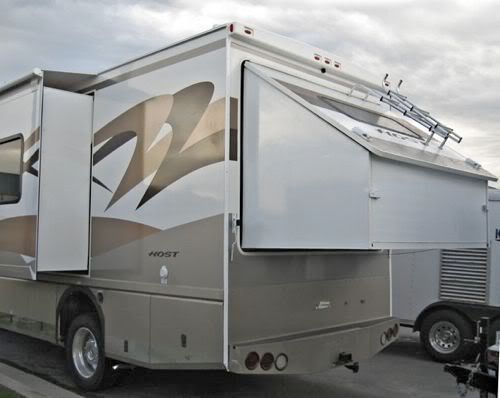VikingVince
Explorer
Jay...thanks for the feedback/input on Host. Did you, by chance, ever discuss with them using the Ford chassis with SRW or does that not work with their build?
VikingVince said:Jay...thanks for the feedback/input on Host. Did you, by chance, ever discuss with them using the Ford chassis with SRW or does that not work with their build?


CapelConcepts said:I'm pretty sure there is no such thing as a SRW F-550. ER just uses a different wheel and tire set up to use a SRW. As for the SRW increasing the off-road prowess I could see that argument going either way ( duals or singles). As far as I can tell....which is about three feet in front of me....ER doesn't do anything to increase the off-road capabilities of there vehicles, so in there the HOST should be just as capable....leaving aside the difference in departure angles. If I'm way off on my observations someone please let me know!
Kermit said:It is quite rare that happens. Logging trucks don't have issues...nor do quarry dumps. I have some buddies who drive their dauls in Baja...never had a problem.
I used to drive dump trucks with dauls, never had rocks jam in there on work sites. I am sure it does happen, just a rarity.
VikingVince said:The main offroad/expedition vehicle criticism of DRW is that rocks can get wedged between the dual tires...can be hassle to remove as well as causing punctures.
mog said:You can run rock-picks if that is an issue were you drive. Perhaps a folding or removalable set that are used in rocky (rocks sized to stick between the tires) areas.
expeditionswest said:By nature of the construction and clearance angles, it would not be appropriate for travel on unimproved surfaces.
I expect it would work great on snow-covered roads or some gravel, but miles of corrugations would need to be avoided. Even 5 miles of heavy corrugations can shake apart the typical RV.
VikingVince said:I agree...I would never take a motorhome like this on any type of washboard roads...that's asking for problems (unlike ER which is designed to tolerate corrugation)...so maybe my use of the term "unimproved dirt road" was not accurate. I was thinking of the many dirt/gravel forest service roads that are easy to travel. Are they improved or unimproved roads? I guess if they're maintained to any degree, then they are "improved." I know many of them here in SoCal would be fine for this motorhome...but you'd still have to be discriminating in your choices.
CapelConcepts said:I must have missed where the ER differs in chassis from the Host. I understand that the ER has a "better" built camper body, but the under pinnings are the same...are they not? From all the info I could find, ER does nothing to improve the off-road capabilities for there vehicles. I understand that they install heavier rate springs in the JK to hold the load and some "heavy duty" shocks, but I believe that is all. If I'm missing something more than marketing telling people that they are "off-road capable" please let me know. I believe the reality of motor homes in this class are that they weigh a LOT and the four wheel drive systems help to get you into (and out of) more places than your typical motor home. Those are my thoughts on this market. I think both vehicles are capable of doing this.
VikingVince said:The overriding significant difference is the way the cabin is attached to the frame. In the ER XV-LT (the motorhome/expedition rig), there is a subframe with the cabin being attached at 3 points to the frame. This prevents the forces of torsional twisting from being transferred into the cabin. In motorhomes like the Host 270, the cabin is directly mounted to the frame. Torsional twisting forces are transferred directly into the cabin causing things to break.
In addition, I believe the ER cabin is a one piece composite shell which "floats" on top of the subframe during torsional twisting. Motohomes are "constructed" - floor, sides, and roof - all of which have seams which over the long run will not hold up to torsional forces...splits, cracks, and leaks. Unfortunately, this design aspect common to all motorhomes makes them ill-suited to washboard roads, torsional twisting...not to mention, they have a terrible reputation for shoddy construction in general and stuff breaking down frequently.
My main point with this Host 270 was that it is just a step in the direction of being a bit more offroad capable and you have a very comfy living space...but it can't compete with an ER. In retrospect, the title of the thread may have been misleading...although I wouldn't mind having a Host 270 and saving fifty grand plus.(although I could never go as many places as I could with the ER)
CapelConcepts said:I see what you are talking about now...with the "floating shell" vs the ridged mount. I thought that was one of the great things about flexing an old motor home was the creaking it made!I guess I just don't look at either of them as "serious" off-road vehicles....which I don't imagine either of them are supposed to be. I look at both of them as nice motor homes that are capable of getting you a little further away from civilization.
I don't think the title was misleading...I think most people looking at this style of motor home would have compared these two right off the bat. For the money that both of them charge I'd like to see some drive train upgrades as well...I mean who wouldn't wouldn't want front and rear lockers in these types of rigs if they really are going off-road?!
